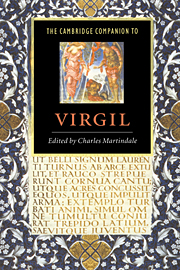Book contents
- Frontmatter
- Contents
- List of illustrations
- List of contributors
- Preface
- 1 Introduction: ‘The classic of all Europe’
- Part 1 Translation and reception
- Part 2 Genre and poetic career
- Part 3 Contexts of production
- Part 4 Contents and forms
- 16 Virgil's style
- 17 Virgilian narrative (a) Story-telling
- 17 Virgilian narrative(b) Ecphrasis
- 18 Approaching characterisation in Virgil
- 19 Sons and lovers: sexuality and gender in Virgil's poetry
- 20 Virgil and tragedy
- 21 Envoi: the death of Virgil
- Dateline compiled by Genevieve Liveley
- List of works cited
- Index
- Plates
21 - Envoi: the death of Virgil
from Part 4 - Contents and forms
Published online by Cambridge University Press: 28 May 2006
- Frontmatter
- Contents
- List of illustrations
- List of contributors
- Preface
- 1 Introduction: ‘The classic of all Europe’
- Part 1 Translation and reception
- Part 2 Genre and poetic career
- Part 3 Contexts of production
- Part 4 Contents and forms
- 16 Virgil's style
- 17 Virgilian narrative (a) Story-telling
- 17 Virgilian narrative(b) Ecphrasis
- 18 Approaching characterisation in Virgil
- 19 Sons and lovers: sexuality and gender in Virgil's poetry
- 20 Virgil and tragedy
- 21 Envoi: the death of Virgil
- Dateline compiled by Genevieve Liveley
- List of works cited
- Index
- Plates
Summary
In 1930 Europe celebrated the bimillennium of Virgil's birth. The celebrations fell in the middle of Mussolini's dictatorship (1922-43), strengthening the links that Mussolini sought to establish between his Italian regime and ancient Rome. The Aeneid, singing of the birth of a new city and a new empire, helped to validate Mussolini's imperialist policies, and in 1936 a new Italian empire was born. In the same year the Austrian writer Hermann Broch began to meditate upon Virgil's position in the modern world and by 1937 he had conceived his novel The Death of Virgil. This envoi will focus in particular on Broch's novel, since it probes and anticipates many of the anxieties attached to twentieth-century responses to Virgil.
The opposed political approaches to Virgil offered by Mussolini and the anti-Fascist Broch typify the variety of Virgilian studies proliferating at this time. A renaissance of interest in Virgil was due not solely to the bimillennium, but more suggestively to the sense of crisis pervading Europe in the entre-deux-guerres period. George Steiner has observed that after the First World War the European ear became more attuned to the Virgilian voice of exile than to the Homeric cry of triumph. Such a claim seems validated by the wealth of Virgilian biographies published in the 1920s and 1930s.
- Type
- Chapter
- Information
- The Cambridge Companion to Virgil , pp. 327 - 336Publisher: Cambridge University PressPrint publication year: 1997

